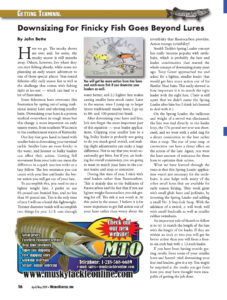Downsizing For Finicky Fish Goes Beyond Lures
Here we go. The musky shows are over and, for some, the musky season is still months away. Others, however, live where they can start fishing already, while some are planning an early season adventure to one of those special places. Year-round fisheries offer early season fun as well as the challenge that comes with fishing right at ice-out — which can lead to a lot of frustration.
Some fishermen have overcome this frustration by opting out of using traditional musky lures and selecting smaller baits. Downsizing your lures is a proven method everywhere in tough times but this change is more important on early season waters, from southern Wisconsin to the southernmost waters of Kentucky.
One key that goes hand in hand with smaller baits is downsizing your terminal tackle. Smaller lures are more finicky in the water, and heavier or bulky leaders can affect their action. Getting full movement from your baits can mean the difference in a quick reaction strike or a lazy follow. The less resistance you can create with your line and leader the better action you will get out of your lure.
To accomplish this, you need to use a lighter weight line. I prefer to use 65-pound test braided line, and no less than 50-pound test. This is the only time of year I will use a braid this lightweight. Thinner diameter braids will accomplish two things for you: 1.) It cuts through water better; and 2.) Lighter line makes casting smaller lures much easier. Later in the season, once I jump up to larger (more traditional) musky lures, I go up to 80- and 100-pound test braid.
After downsizing your lures and line, let’s not forget the most important part of this equation — your leader applications. Clipping your smaller lure to a big, bulky leader is probably not going to do you much good overall, and making slight adjustments can make a huge difference. Not to say that you won’t occasionally get bites, but if you are looking for overall consistency, you are going to want to match your lures to the correct leader and snap or connector.
During this time of year, I stick with steel leaders rather than fluorocarbon.
This is mainly due to the bulkiness of fluorocarbon and the fact that if you use lighter-weight fluorocarbon you risk getting bit off. The risk is not worth it. At this point in the season, I believe it is far more important to get full action out of your lures rather than worry about the invisibility that fluorocarbon provides. Action trumps invisibility!
Stealth Tackle’s Spring Leader concept has really become popular with rattlebaits, which is probably the lure and leader combination that started the whole concept of downsizing many years ago. Tony Grant approached me and asked for a lighter, smaller leader that would get him more action out of his Rattlin’ Shad baits. This really showed us how important it is to match the right leader with the right lure. (Tony is still upset that we didn’t name the Spring Leader after him but I think he’s learned to deal with it.)
On the Spring Leader, the bulkiness and weight of a swivel was eliminated, the line was tied directly to the leader loop, the 174-pound test wire was shortened, and we went with a solid ring for a direct connection to the lure rather than a snap. The size of your snap or connection can have a direct effect on the action of the lure. Again, you want the least amount of resistance for these lures to optimize their action.
What we have learned through the years is that this Spring Leader application wasn’t just necessary for the rattlebaits, it also helps with many of the other small lures that are available for early season fishing. They work great with small glide baits and jerkbaits, by inverting the Spring Leader and adding a small No. 3 Stay-Lok Snap. With the addition of a swivel, it will work well with small bucktails as well as smaller rubber swimbaits.
An important rule of thumb to follow is to try to match the length of the lure with the length of the leader. If they are within an inch or two you will get far better action than you will from a four to six-inch bait with a 12-inch leader. If you have been having trouble getting results from some of your smaller lures and haven’t tried downsizing your line and leaders, give it a try. You might be surprised at the results you get from lures you may have thought were incapable of getting the job done.

